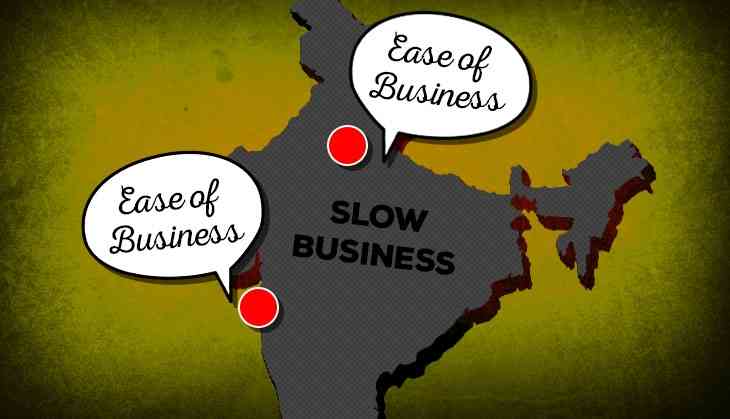Ease of doing business: India has improved only for big players, not SMEs

India's rise in the Ease of Doing Business rankings has given new vigour and face to the Narendra Modi government. It will help the government defend itself against the daily jibes coming from the Opposition on ruining the India's economic growth story.
Facing two crucial state Assembly elections, the BJP would use the fact that India has broken into the top 100 club in the Ease of Doing Business out of the 190 tracked by the World Bank.
Ranked 130 a year ago, India has been adjudged the fifth best-performing country in reforming the business environment.
Between June 2, 2016 and June 1, 2017, India improved in nine out of 10 categories in making processes easy for doing business, according to the World Bank.
So, has India become a haven for investors?
Let's look at the areas where World Bank has commended India:
- Paying tax
- Resolving insolvency
- Getting credit
- Protecting minority interests
Paying taxes
India jumped 53 places to reach a rank of 119 in the ‘paying taxes’ category. World Bank believes that the Goods and Services Tax implemented by the government of India from July1, 2017 has made the process of paying taxes easier.
On paper, it is definitely easier to pay taxes online. And this is why World Bank's Vice President for South Asia, Annette Dixon, told The Hindu, “We know that if a country improves its Doing Business rankings, the economy performs better, particularly in terms of supporting Small and Medium Enterprises (SMEs), growth and jobs. Here in India, SMEs are rather small compared to other countries. The average SME in India employs just six people, which is pretty small. If the doing business environment improves, we would expect to see SMEs able to grow and create more jobs for Indians.”
Unfortunately, on the ground it is India’s SMEs, especially those that employ less than 10 people, which are facing the threat of extinction due to increased compliance cost under the GST.
Call it an Ease of Doing Business irony, only 3.94 million of the total 8 million assessees filed their GSTR 3B returns for the month of September, 2017. A majority of those who failed to meet their deadline are from the SMEs.
Resolving insolvency
Let's assess the World Bank's assessment of India's ability to resolve insolvency cases.
Indeed, it has become easier to exit a failed business in India over the last one year. The National Company Law Tribunal has so far taken decision on 655 cases under the Insolvency and Bankruptcy Code. India has indeed has become a place whre a failed business can shut its shop within 180 days.
Getting credit
India now ranks 29 in the world in terms of making credit available for businesses. It is another matter that the time period when India achieved this ranking was one of the worst times in terms of credit growth in the country.
Credit growth in India plunged to a six-decade low of 5.08% in 2016-17 against 10.7 per cent a year ago.
If the data above is 6 months old, an Economic Times report on October 31, 2017 said “Credit to industry contracted by 0.4% on a year-on-year (y-o-y) basis in September 2017 as compared with an increase of 0.9% in September 2016.
Here the Modi government has its task cut out for the rest of the year. The challenge is to convince industry to take more credit as India has made it easier to apply for commercial loans. A better thing would be to generate demand in the economy that gives industry a reason to invest more in the economy.
Protecting interests of minority investors
Last but not least. India now ranks 4th in the world when it comes to protecting interests of minority investors. Till last year, when India was ranked 130th in the overall rankings, the country was ranked 13th in this category. There have been instances when minority shareholders have challenged mergers and acquisition between two companies and managed to get stays from the regulators (read Trinetra Cements & India Cement)
However, there is a need for the government to improve the scope and definition of what makes a minority investor. India's bankruptcy law recently faced a situation that it was not prepared to deal with.
The home-buyers of the Jaypee Infratech moved the Supreme Court to halt the process of insolvency of the company. The Insolvency and Bankruptcy Code, 2016 categorises home buyers as unsecured creditors. However, it is the upfront investment made by these buyers that helps real estate companies complete their housing projects. One loophole in the bankruptcy law undermined India's ability credibility on two important categories – resolving insolvency and protecting minority investors- where India scored big in the ease of doing business rankings.
While it would be incorrect to agree with Congress party Abhishek Manu Singhvi's comment that India's rise in the World Bank ease of doing business ranking was fixed, there is no doubt that this rise - very big and real- does not tell the real story about troubles that Indian economy faces today.
The rankings given by the World Bank are based on the agency's survey in only two metros cities - Delhi and Mumbai - whereas the trouble that the Indian economy faces due to demonetisation and introduction of complex GST are visible in hundreds of small towns across the length and breadth of the country. The government may have done something for big investors in the country, but in the words of Finance Minister Arun Jaitley, “Bulk of the jobs in India are created by SMEs, by the micro-industries and self employment. Gone are the days where only the government sector created jobs in the government or the organised sector created jobs”.
Maybe the World Bank should come up with another ranking that assesses India on those parameters.
First published: 2 November 2017, 0:20 IST

